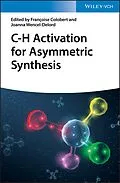Written by leading international authors in the field, this book introduces readers to C-H activation in asymmetric synthesis along with all of its facets. It presents stereoselective C-H functionalization with a broad coverage, from outer-sphere to inner-sphere C-H bond activation, and from the control of olefin geometry to the induction of point, planar and axial chirality. Moreover, methods wherein asymmetry is introduced either during the C-H activation or in a different elementary step are discussed.
Presented in two parts?asymmetric activation of C(sp3)-H bonds and stereoselective synthesis implying activation of C(sp2)-H bonds?CH-Activation for Asymmetric Synthesis showcases the diversity of stereogenic elements, which can now be constructed by C-H activation methods. Chapters in Part 1 cover: C(sp3)-H bond insertion by metal carbenoids and nitrenoids; stereoselective C-C bond and C-N bond forming reactions through C(sp3)?H bond insertion of metal nitrenoids; enantioselective intra- and intermolecular couplings; and more. Part 2 looks at: C-H activation involved in stereodiscriminant step; planar chirality; diastereoselective formation of alkenes through C(sp2)?H bond activation; amongst other methods.
-Covers one of the most rapidly developing fields in organic synthesis and catalysis
-Clearly structured in two parts (activation of sp3- and activation of sp2-H bonds)
-Edited by two leading experts in C-H activation in asymmetric synthesis
CH-Activation for Asymmetric Synthesis will be of high interest to chemists in academia, as well as those in the pharmaceutical and agrochemical industry.
Francoise Colobert is director of the chemistry department of the Chemistry engineering High School ECPM at the University of Strasbourg. She received a Ph.D. in organic chemistry in 1985 from the University Pierre et Marie Curie (Paris, France) working with Prof. Jean-Pierre Genet. After a post-doctoral position in the group of Prof. Jules Hoffman in molecular biology, Francoise Colobert became an assistant professor in the group of Prof. Guy Solladie (University Louis Pasteur, Strasbourg) and obtained her habilitation (HDR) in 1999. She was appointed full professor of organic chemistry in 2001.
Her current research interests are oriented towards homogeneous catalysis, in particular C-H activation directed by sulfoxides, C-C asymmetric biaryl coupling by Suzuki-Miyaura and aryne couplings or by C-H activation; the synthesis of new biaryl ligands for asymmetric catalysis and the total synthesis of biologically active molecules.
Joanna Wencel-Delord was educated in chemistry at the Ecole Nationale Superieure de Chimie de Rennes, France and she received her PhD in 2010 from the University of Rennes 1, France (Dr. C. Crevisy and Dr. M. Mauduit). After postdoctoral studies with Prof. F. Glorius at the Westfalische Wilhelms-Universitat Munster (Germany) and temporary assistant professor position (ATER) at the University of Strasbourg (Prof. P. Compain), she joined in 2013 CNRS as associate researcher in the group of Prof. F. Colobert (University of Strasbourg, France). Her research focuses on the transition metal-catalyzed asymmetric C-H activation.
Autorentext
Françoise Colobert, PhD, is director of the team Syncat: Synthesis and asymmetric catalysis of the Chemistry Engineering High School ECPM at the University of Strasbourg. Her current research interests are oriented towards homogeneous catalysis, in particular C-H activation directed by sulfoxides.
Joanna Wencel-Delord, PhD, was educated in chemistry at the Ecole Nationale Supérieure de Chimie de Rennes, France. Her research focuses on the transition metal-catalyzed asymmetric C-H activation.
Inhalt
Foreword xi
Part I Asymmetric Activation of C(sp3)H Bonds 1
Part I.A C(sp3)H Bond Insertion by Metal Carbenoids and Nitrenoids 2
1 Stereoselective CC Bond-Forming Reactions Through C(sp3)H Bond Insertion of Metal Carbenoids 3
Aoife M. Buckley, Thomas A. Brouder, Alan Ford, and Anita R. Maguire
1.1 Introduction 3
1.2 Diazo Compounds 4
1.3 Mechanistic Understanding 5
1.4 Catalysts 7
1.4.1 Copper 7
1.4.1.1 Bisoxazoline and Schiff Base 7
1.4.2 Rhodium 8
1.4.2.1 Rhodium(II) Carboxylates 9
1.4.2.2 Rhodium(II) Carboxamidates 10
1.4.2.3 Ortho-metalated Complexes 11
1.4.3 Iridium and Ruthenium 11
1.5 Intramolecular C(sp3)H Bond Insertion 11
1.5.1 Chemoselectivity 13
1.5.1.1 Catalyst Effects 13
1.5.1.2 Substrate Effects 14
1.5.2 Regioselectivity 16
1.5.2.1 Formation of Three-Membered Rings 17
1.5.2.2 Formation of Four-Membered Rings 18
1.5.2.3 Formation of Five-Membered Rings 20
1.5.2.4 Formation of Six-Membered Rings 20
1.5.3 Diastereoselectivity 23
1.5.3.1 Substrate Effects 23
1.5.3.2 Catalyst Effects 25
1.5.4 Enantioselectivity 25
1.6 Intermolecular C(sp3)H Bond Insertion 30
1.6.1 Chemoselectivity 30
1.6.1.1 Diazo Compounds 32
1.6.1.2 Catalyst Effects 34
1.6.1.3 Substrate Functional Groups 35
1.6.2 Regioselectivity 36
1.6.2.1 Substrate Effects 36
1.6.2.2 Catalyst Effects 38
1.6.2.3 Diazo Compound Effects 39
1.6.3 Diastereoselectivity 39
1.6.3.1 Substrate Effects 39
1.6.3.2 Catalyst Effects 42
1.6.4 Enantioselectivity 43
1.7 Conclusion 45
References 45
2 Stereoselective CN Bond-Forming Reactions Through C(sp3)H Bond Insertion of Metal Nitrenoids 51
Philippe Dauban, Romain Rey-Rodriguez, and Ali Nasrallah
2.1 Introduction 51
2.2 Historical Background 52
2.2.1 Seminal Studies in Catalytic C(sp3)H Amination 52
2.2.2 Mechanistic and Stereochemical Issues 56
2.3 Catalytic Stereoselective C(sp3)H Amination Reactions with Iminoiodinanes 60
2.3.1 Catalytic Intermolecular Enantioselective Reactions (Chirality Only on the Metal Complex) 60
2.3.2 Catalytic Intramolecular Enantioselective Reactions 63
2.3.3 Catalytic Intermolecular Diastereoselective Reactions (Chirality on the Metal Complex and the Nitrene Precursor) 66
2.4 Catalytic Stereoselective C(sp3)H Amination Reactions with Azides 67
2.4.1 Transition Metal-Catalyzed C(sp3)H Amination Reactions 67
2.4.2 Enzymatic C(sp3)H Amination Reactions 68
2.5 Catalytic Stereoselective C(sp3)H Amination Reactions with N-(Sulfonyloxy)carbamates 70
2.6 Conclusion 72
References 72
Part I.B C(sp3)H Activation as Stereodiscriminant Step 77
3 Enantioselective Intra- and Intermolecular Couplings 79
Qiaoqiao Teng and Wei-Liang Duan
3.1 Introduction 79
3.2 Enantioselective Intramolecular Couplings of Aliphatic Substrates 79
3.2.1 CC Coupling 79
3.2.2 CX Coupling 89
3.3 Enantioselective Intermolecular Couplings of Aliphatic Substrates 90
3.3.1 Pd Catalysis 91
3.3.2 Rh Catalysis 102
3.3.3 Ir Catalysis 102
3.4 Conclusion 104
References 105
4 Substrate-Controlled Transformation: Diastereoselective Functionalization &...
